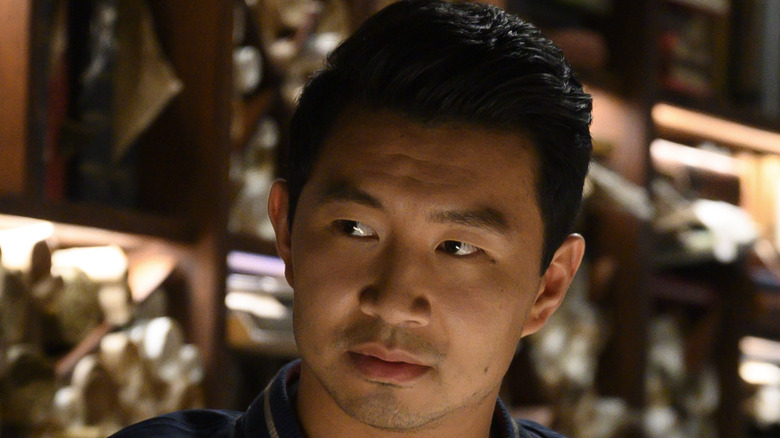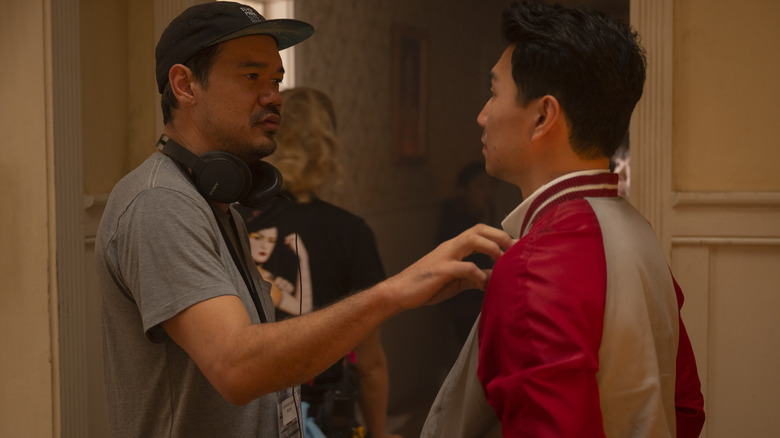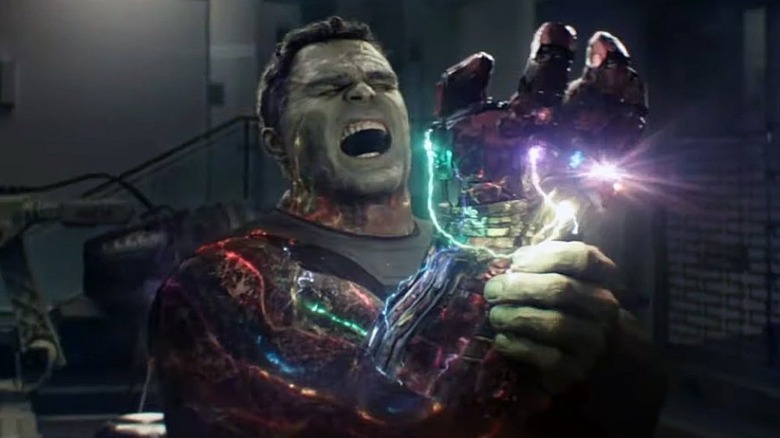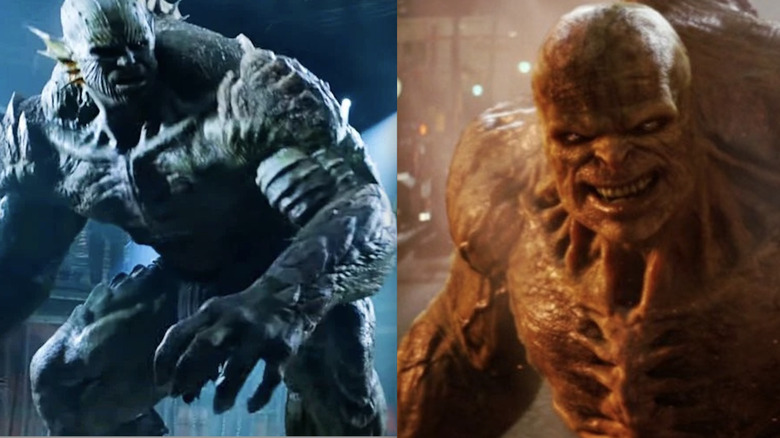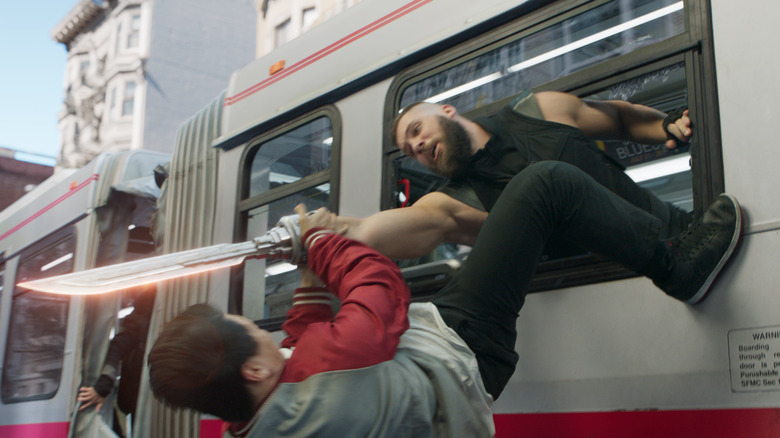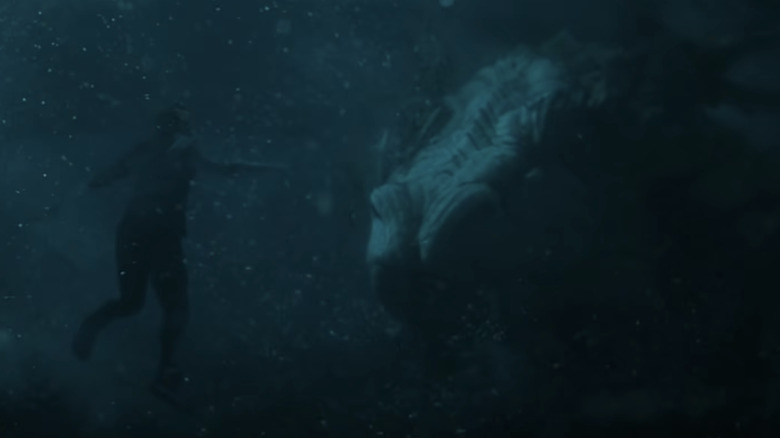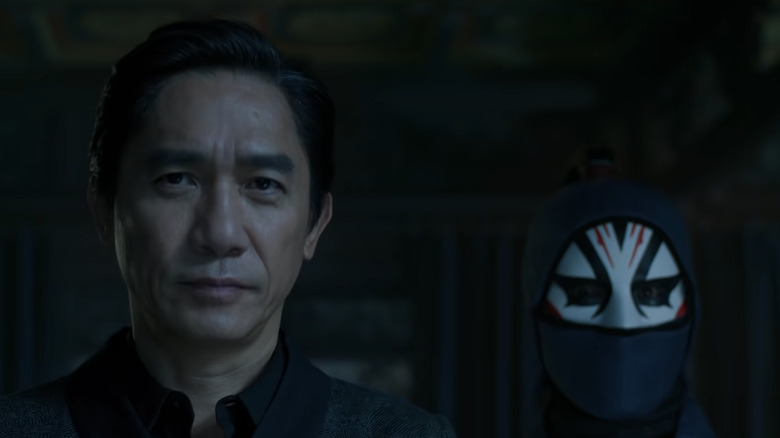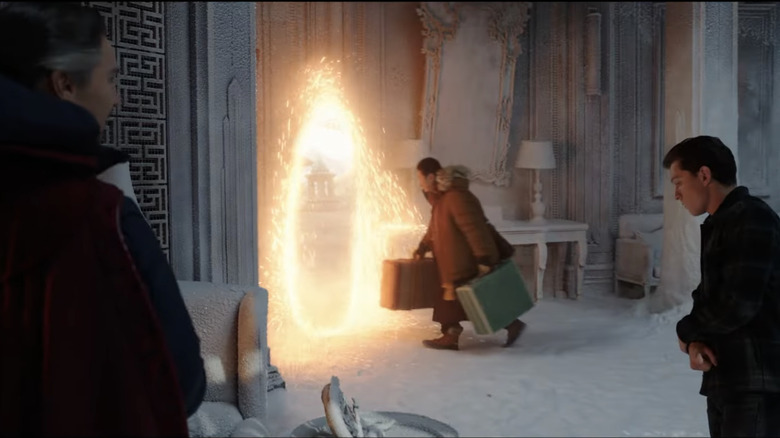Easter Eggs You Missed In Shang-Chi And The Legend Of The Ten Rings
Whenever there's a new Marvel movie in theaters, you just know it's going to be chock full of the tiny little details we all love to look for.
Some MCU Easter eggs make reference to other movies, going back a decade or more. Others give a sly wink to comic books your parents (or their parents) read as kids. No matter what the nature, they're fun to look for — and perhaps no recent MCU film has more of them than "Shang-Chi and the Legend of the Ten Rings."
With that in mind, below are a list of (super spoiler-heavy) eggs littered throughout "Shang-Chi." As you watch the movie, keep your eyes peeled for these and more — and after you've seen the film, come back and read this breakdown to make it feel like Easter morning all over again.
Snap, crackle and pop
Writer/director Destin Daniel Cretton has gone on record saying "Shang-Chi" is set after the Blip, when all the victims of the Snap have returned. This is further supported by once bitten, twice-shy lines in "Shang-Chi" like "We're living in a world where any minute, half the population could disappear," as well as a poster that can be glimpsed outside the door to Katy's home.
Take a close look at the scene early in "Shang-Chi" when Shaun visits Katy and her family. As he pulls open the exterior door to her building, you can see a flyer reading "Post-Blip anxiety? You are not alone."
This might be the kind of sign that advertised Steve Rogers' support group that he hosted after the Snap, as seen in "Avengers: Endgame." Of course, that scene took place before everyone's return, and Steve ultimately was giving advice that he may have soon regretted: "You gotta move on..."
The group advertised in "Shang-Chi" seems to be not only for those with loved ones who vanished, but also the very loved ones who returned. At the time when "Shang-Chi" is set, anxiety is a common affliction. If half the world went away before, who's to say it can't happen again? Now that androids, aliens, and wizards are commonplace, how can a normal person feel like anything other than an ant, hoping to not get squashed?
Subtle clues, to be sure — but ones that set a distinctive backdrop for the Marvel movies and TV shows of this new era.
Hulk, Smashed
In the mid-credits scene, Shang-Chi and Katy have a conversation with a virtual Captain Marvel (Brie Larson) and Bruce Banner (Mark Ruffalo). Along with Doctor Strange wingman Wong (Benedict Wong), the braintrust is extremely interested in the Ten Rings, the tale of how Shang-Chi acquired them, and their true nature.
"Not like any alien tech I've seen," says Carol Danvers.
"The thermal lumens are ridiculous," observes Banner.
Eventually, they seem to conclude that the Rings are some sort of beacon, sending a message. Then Banner signs off by saying: "Guys, stay safe. Welcome to the circus."
It's a fun cameo scene that seems to set up our heroes for future Avengers collaborations. But sharp-eyed viewers might also notice that Banner's right arm is in a sling. Any guesses why?
If you said the return Snap, give yourself a gold star. As you recall, in "Endgame" it was determined that only the Hulk was strong enough to wear the Iron Gauntlet and snap everyone back into existence. But in doing so, he was exposing himself to massive gamma radiation ("It's like I was made for this," he said), and sure enough, he fried his arm.
In a 2019 interview with ComicBook.com, "Endgame" director Joe Russo said the damage is permanent. "He's lost an arm ... that's not coming back," he said. "He's damaged himself. It's permanent damage, the same way there was permanent damage with Thanos. It's irreversible."
So, will Bruce Banner spend the rest of his MCU games with his arm in a sling? In a world where Thor can pop in a new eye and Rhodey can become paralyzed from a fractured spinal column but walk again with help from Stark bionic supports, no injury seems truly permanent. We'll see how long Ruffalo has to keep wearing the sling, but in this, his first Hulk scene since "Endgame," it's clear that he's still in a bad way.
Abomination's Absolution
Sharp-eyed fans were delighted when, earlier this summer, they seemed to uncover a quick shot of Abomination in the "Shang-Chi" trailer. Sure enough, when our newly-revealed hero makes his way back to China in an attempt to locate his sister Xialing, he looks for her at The Golden Daggers Club and discovers that not only does she run the place, but currently appearing on the main stage is a smackdown between the "Incredible Hulk" villain and Wong.
For starters, there are several things worth discussing about Emil Blonsky's monstrous appearance. First, he seems to be evolving (or, at the very least, the CGI is getting better — after all, it has been 13 years since we last saw the guy). He now has ear fins that look fully engaged, and he boasts more prominent dorsal spine needles — both signatures that make Abomination stand out on the comic book page. The second interesting thing worth noting is that the character looks even less like Tim Roth than he did before — which is saying something, because he has never really looked much like the "Reservoir Dogs" legend. Over the last decade-plus, Marvel fans have watched as Hulk has increasingly resembled the actor who played him — again, the result of improved CGI for sure, but also Avengers storylines that want to blur the line between the series' increasingly-strong Dr. Jekyll and increasingly-brainy Mr. Hyde. But while "The Incredible Hulk" gave us an Abomination whose face at least somewhat resembled a human's reactions, the Abomination character design now seems to be moving in the opposite direction of Hulk, leaving all humanity behind.
Perhaps the most notable thing about this Abomination, however, might be his shift in tone. As you may recall, after Abomination nearly defeated Hulk in Harlem, General Ross (William Hurt, most recently seen in "Black Widow") had the creature locked up in a high-tech cell in Alaska; Phil Coulson said in a 2014 episode of "Agents of S.H.I.E.L.D." that he was still in that cryo-cell. But in the 2011 "One-Shot" short film "The Consultant," an angry Coulson says the World Security Council wants Abomination released and assigned to ... the Avengers initiative?
"They consider Blonsky a war hero," Coulson says. "They want him exonerated, released, and added to the roster."
In a conclusion played for laughs, S.H.I.E.L.D. reveals in the short film that they purposefully sent Tony Stark to screw up the negotiations — leading to the "Incredible Hulk" post-credits cameo where he clashed with a hard-drinking Ross — and as a result, Blonsky went back into his cage. "Ross got so mad he tried to have him removed from the bar — Stark bought the place and it's scheduled for demolition on Thursday," Coulson says. "The Abomination will remain in his cage for now."
But clearly, in "Shang-Chi," Blonsky is not only on the loose, but he seems to be chummy with Wong — who "Shang-Chi" reveals to be a major player in the recruitment of new Avengers. Could it be that (whatever remnants remain of) the World Security Council finally got their way, and Abomination will soon be fighting on the same side as Hulk? Abomination is gearing up to appear more frequently in the Marvel sandbox, including the upcoming "She-Hulk" Disney+. Perhaps this time Marvel will pay for a proper Russian dialect coach.
Razor burn
The first real indication to Shaun that his reality is about to get very, very expanded is when he and Katy are attacked on a San Francisco bus by several highly-trained men — one of them wielding a machete in place of his right forearm.
As well-read comic fans will be eager to point out, his name is Razor Fist (played by Florian Munteanu in the movie), and you wouldn't want to try and shake his hand. In the comics, Razor Fist was introduced in 1975 in "Master of Kung Fu" #29 and had a razor-sharp blade on each arm — not that it helped him much, as he died three issues later.
Of course, anybody who dies in comics is never really dead, so the evil Carlton Velcro attempted to create more Razor Fists in 1981, when brothers William and Douglas Scott were in a car accident and he gave them sword arms; Douglas died and William became the new Razor Fist. In more recent years, that Razor Fist has appeared in various comics, usually seen as supporting muscle for supervillains — much like we find him in "Shang-Chi."
As we later learn in the movie, Razor Fist has a sweet ride. When Shang-Chi, Katy and the others are looking to escape from the clutches of Wenwu, they hijack a modified BMW with teeth on the front grille, vanity plates that read "RZRFST" and the spray-painted words "Razorfist" across it's body. "Hey," exclaims the assassin. "That's my car!"
Thankfully, Razorfist has an affinity for small, fast-moving vehicles — and his whip turns out to be perfect for speeding through the shifting jungles that surround Ta-Lo. Razorfist is eventually reunited with his vehicle when he shows up in Ta-Lo alongside Wenwu, at first supporting the rapidly-leaning-evil wielder of the Ten Rings, then realizing the mission has turned into an every-man-for-themselves situation. After being attacked by one of the flying denizens of the Dark Gate, he says "We shall work together!" and gets a serious weapons upgrade, swapping out his signature blade for a new one reinforced with Dragon's Gate scales.
Here be dragons
In what is a longtime Shang-Chi hallmark, and quickly also becoming one of Awkwafina (whose last movie "Raya and the Last Dragon," had a strangely similar ending), the film concludes with people riding on the back of twisty, flying dragons. A recurring theme in this corner of the Marvel universe (and, of course, Chinese mythology in general), we see a young Shang-Chi being told "When you have the heart of our dragon, you can do some amazing things," and a cryptic postcard depicting a red dragon is what calls the hero home.
Later, Katy marvels "That dragon vomited a magical water map!" after witnessing the magic of Wenwu's statue, and by the time our heroes get to Ta-Lo, "Dragon's Gate" scales have reinforced all their armor and weaponry. "We are the keepers of the Dark Gate," Shang-Chi and his compatriots are told of a long-ago battle involving the so-called Dweller-in-Darkness. "They were headed to your universe ... the Great Protector joined the fight and turned the tide."
To the more casual viewer, it might seem like there are two dragons in play at the end of the movie: a good one and a bad one. The good one is named in the aforementioned line — it is "The Great Protector," the dragon who has laid dormant underwater for some time, and is awoken by Shang-Chi to once again save the day. This is where things get complicated.
In the comics, the far-more-well-known dragon is Fin Fang Foom, a mighty alien lizard creature who came to Earth with other "Dragons" long ago, and brought the Ten Rings with him. But once again, the sketchy history of the "Shang-Chi" character comes into play — it would be shocking if the MCU decided to employ the name "Fin Fang Foom" in the year 2021. As such, it's a page-one rewrite of this particular element of the character's mythology, and he might possibly now be called "The Dweller-of-Darkness" — taking the name of a Doctor Strange villain who bares only a passing resemblance.
The bottom line? Roll over, Daenerys Targaryen — pop culture has some new super-cool dragons to fall in love with.
What's the Deal with that guy?!?
In the background of almost every scene containing Wenwu, you may have noticed a silent man dressed in black, wearing white make-up punctuated by streaks of red and black, looking like he's auditioning for the role of Yokai in a live-action "Big Hero 6" movie. That guy's name is Death Dealer, and for good reason.
In the comics, the character's real name is Li-Ching-Li, and like other characters in Shang-Chi's orbit, he has a history with MI-6. The baddie was actually a double agent, working on the sly for Fu Manchu when he and Shang-Chi had an epic battle that nearly killed him — and he then took on the Death Dealer persona.
In "Shang-Chi and the Legend of the Ten Rings," this Death Dealer has clearly been with Wenwu for multiple decades — and seems to have largely led the training that made Shaun recall: "From sun up to sun down, I was taught every possible way to kill a man."
As Shaun sits on the long flight to China with Katy, telling his life story (and being rudely interrupted by the flight attendant), we see in flashback the Death Dealer silently watching over the boy's training. He is there during the epic scaffolding fight (squaring off 1-on-1 with Shaun after a failed escape), and he returns in the battle at Ta-Lo as well. The mysterious nature of the live-action character, coupled with the lack of dialogue, has given rise to some interesting theories about Death Dealer — including one that he might actually be a she.
Far from home
Okay, technically this Easter egg isn't in "Shang-Chi and the Legend of the Ten Rings," but you'll likely glimpse it in one of the trailers that plays before the film.
In the brand new, mind-blowing, multiverse-expanding first trailer for "Spider-Man: No Way Home," Dr. Stephen Strange (Benedict Cumberbatch) makes the really, really bad decision to cast a spell that will make the entire world forget that Peter Parker (Tom Holland) is Spider-Man. Under normal circumstances, an MCU fan would say: "No way. Wong would never let such an irresponsible thing happen. He's the voice of reason."
Great point. But when the cat is away, the mouse will play. So, while we see Wong in the trailer instructing Strange not to mess with the spell, we also see him in a winter parka, holding two suitcases and traveling somewhere that looks like it has old, regal structures adorned by columns and domes. Which is when Strange casts his spell on Peter's behalf, and all hell breaks loose.
Those who've seen "Shang-Chi" know that Wong pops up multiple times in China, as well as San Francisco. So, could either of those be where he's teleporting to in the trailer? Do the events of that scene run concurrent to "Shang-Chi"? We'll find out soon enough, once Spidey's latest adventure slings itself into theaters.
